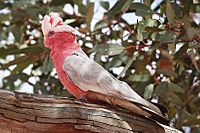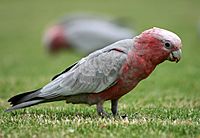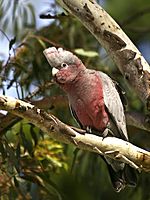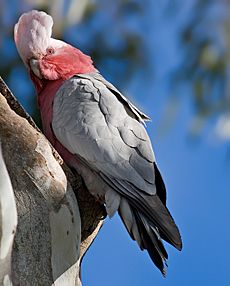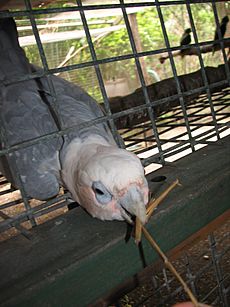Galah facts for kids
Quick facts for kids Galah |
|
|---|---|
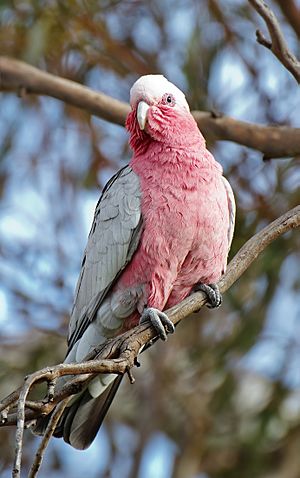 |
|
| A male galah in Tasmania | |
| Conservation status | |
| Scientific classification | |
| Genus: |
Eolophus
|
| Species: |
roseicapilla
|
| Subspecies | |
|
|
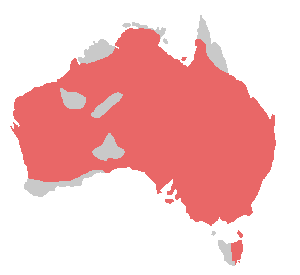 |
|
| Galah range (in red; all-year resident) | |
| Synonyms | |
|
|
The galah (Eolophus roseicapilla) is a very common bird in Australia. It is also known as the pink and grey cockatoo or rose-breasted cockatoo. This bird is the only species in its group, called Eolophus, which is part of the cockatoo family.
You can find galahs all over Australia. They are one of the most common types of cockatoos. With their bright pink and grey feathers, and their loud, playful behavior, they are easy to spot. You can see them in the wild and more and more in cities. Galahs have actually done well because of changes to the land since Europeans arrived. They seem to be taking the place of the Major Mitchell's cockatoo in some areas.
Contents
Etymology
The name "galah" comes from an Aboriginal word. It comes from gilaa, a word from the Yuwaalaraay language. This word is also used in other nearby Aboriginal languages.
Description
A galah is about 35 centimeters (14 inches) long. It usually weighs between 270 and 350 grams (9.5 to 12.3 ounces). This bird has a light silver to grey back. Its lower back is also pale grey.
The galah's face and chest are pink. It has a light pink crest on its head that can move. Its beak is bone-colored. The skin around its eyes is bare and has small bumps. Galahs have grey legs.
Male and female galahs look quite similar. However, you can tell them apart by their eyes. Adult males have very dark brown, almost black, eyes. Adult females have reddish-brown eyes. Young galahs are not as brightly colored. Their chest, head, and crest are greyish. Young birds have brown eyes and smooth, whitish skin around their eyes.
-
A juvenile galah feeding on a metropolitan lawn in Sydney
-
Juvenile in Wamboin, New South Wales
Distribution and habitat
Galahs live all over Australia. They are not found only in the driest places or the very north of Cape York Peninsula. Galahs have been seen in Tasmania since the 1840s. But it's not clear if they are naturally from that island.
These birds are common in big cities like Adelaide, Perth, and Melbourne. They love open areas with some scattered trees for shelter. When Europeans settled in Australia, they cleared forests. They also created water sources in dry areas. These changes were bad for many animals. But they were very good for the galah.
Galahs often gather in large groups. These groups can have from 10 to 1,000 birds. Sometimes, different types of birds join these groups. This can include Major Mitchell's cockatoo, the little corella, and the sulphur-crested cockatoo. Galahs can even have babies with these other species. Large groups of galahs often look for food on the ground. They like open, grassy areas.
Subspecies
There are usually three types of galahs recognized. These are called subspecies. They have small differences in their feather colors. Also, the skin around their eyes can look a bit different.
The galah from south-eastern Australia is called E. r. albiceps. It looks different from the paler galah from Western Australia. That one is called E. r. roseicapilla. Most pet galahs outside Australia are the south-eastern type. The third type, E. r. kuhli, lives across northern Australia. It is usually a bit smaller. It also has a different shaped and colored crest. But scientists are not fully sure if it's a separate subspecies.
Reproduction
Galahs build their nests inside holes in trees. The eggs are white. A female galah usually lays two to five eggs at a time. Both the male and female galah take turns sitting on the eggs. They do this for about 25 days. The baby chicks leave the nest about 49 days after they hatch.
Lifespan
In zoos or as pets, galahs can live a very long time. They can reach up to 80 years old if they eat a healthy diet. They are very smart birds. They like to play and be social.
In the wild, galahs usually do not live past 20 years. They face dangers like cars and predators. Predators include birds like the little eagle, black falcon, and peregrine falcon. Human activities in farming areas can also be a danger. Like most cockatoos, galahs form strong bonds with their partners. These bonds last their whole lives.
Hybrids
Galahs can have babies with other bird species. These babies are called hybrids. They can hybridize with several types of birds. This includes the sulphur-crested cockatoo and the little corella. They can also hybridize with Major Mitchell's cockatoo and the cockatiel.
Hybrids of a galah and a cockatiel are sometimes called "galatiels". Some hybrids of galahs and Major Mitchell's cockatoos have been bred in Sydney. These birds have the galah's wing shape. But they have the crest and colors of the Major Mitchell's cockatoo. They also make the sad cry of the Major Mitchell's cockatoo.
Images for kids
See also
 In Spanish: Cacatúa Galah para niños
In Spanish: Cacatúa Galah para niños



